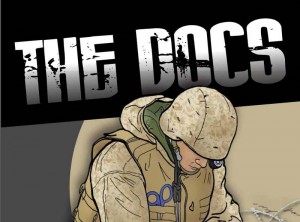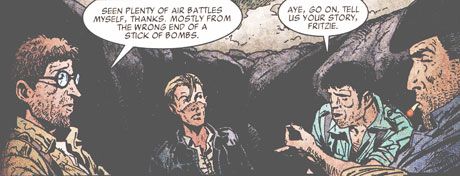 |
|
Miracle Pictographs
|
July 2011
Truthfully, grandson, I shoveled crap in Louisiana during World War II.
The Docs: A Graphic Novel By The Naval Health Research Center; War Stories: Vols. 1-2 (Vertigo 2004)
The other day, when I was eating my American-style hamburger with freedom
fries, washed down with a gallon of good old American corn syrup, I realized that
although the logical thing to do in this column would be to write about a Captain
America comic . . . I didn't really want to.
I've done superhero columns for all of 2011. I've had superhero movies up the
proverbial yin-yang. Hammers and mutants and green rings oh my!
And although I'm sure the Cap movie will be just as much summer fun as Thor,
Iron Man and X-Men: First Class, it is a little more difficult to reconcile a fantasy
superhero to a genuine war. In the most recent Captain America trailer, we see a
clip from the movie in which Tommy Lee Jones, playing an archetypal hard-bitten
corporal, tosses a dud grenade to the ground and Steve Rogers, previous to his
transformation into the good Captain, jumps on the grenade to save his buddies.
The grenade doesn't go off and Rogers scrambles to his feet, asking, "Was that a
test?"
I recently read about another grenade and another unusual soldier: On Thursday,
April 5, 1945, Sadao Munemori, a Japanese-American soldier serving in the 100th
Infantry Battalion in Italy, leaped on a German hand grenade to save his nearby
friends. Unlike Steve Rogers, he was blown to pieces.
He became the first and only Japanese-American soldier to be recommended for
the Medal of Honor in wartime. (Many of his compatriots received the Medal of
Honor in 2000, after an investigation determined that 1940s racist policies had
prevented living Japanese-Americans from the award.)
Sadao Munemori had been an auto mechanic supporting his immigrant mother and
family after his father's death. In 1941, he attempted to enlist in the Army and was
classified 4-C, "enemy alien." Shortly after that, he lost his business and home
when his family was shipped to the Manzanar internment camp, in central
California.
Continued Below Advertisement
Munemori was eventually recruited by the Military Intelligence Service and
earmarked for a job as a translator and interrogator in the Pacific War, but he
transferred to the infantry in order to see some action.
He fought with the infamous 442nd Regimental Combat Team in Italy. This group
of Japanese-American males were famous for their ridiculous feats of heroism. As
they often said, they felt like real Americans, and were determined to prove it by
going far beyond the typical wartime acts of heroism.
Future Hawaiian state Senator Daniel Inouye, now the eldest sitting senator in
Congress, was shot in the stomach, had his arm blown off, and was shot in the leg
as he attacked a German gun emplacement. Undeterred, he pried a grenade from
his severed hand with his remaining hand and tossed it at the German machine gun.
James Okubo, a medic from my town of Bellingham, Washington, whose parents
had also lost their business and been interned, won the Silver Star for repeated runs
through rugged Italian terrain and hails of gunfire in order to drag wounded men to
safety.
(Read more in the book Rising Sons by Bill Yenne, which cries out for a Band of
Brothers-style adaptation. Listen to me, HBO!)
I feel a little strange when people say that American troops "defend our freedom"
or "save our country." Sadao Munemori was fighting for a country that took
everything he had and threw his family in prison, simply for their ethnicity, and
there is a good argument that he might have done more good by staying home in
the internment camp. That's not freedom.
But he fought against a very real evil in the hopes that he could change the evil
policies of his own country.
And that -- the hope that your life might create a better world, checked against
your own conscience and loyalty -- is indeed heroism.
So in that tradition, The Docs: A Graphic Novel By The Naval Health Research
Center, for all that it is produced by a US military institution, is less about flag-waving and blind patriotism than it is about the difficult life of US Marines in Iraq,
and the heavy responsibilities of the Navy corpsmen who serve as their medics --
the "docs."

I got a copy from a friend who works with said Naval Health Research Center. The
Docs is meant to demonstrate, through real-life-based situations, the ideal actions
of a Navy corpsman assigned to a Marine Corps platoon. Like Band of Brothers, it
uses entertainment to more thoroughly display the qualities of a good soldier in a
way that lectures and typical training cannot do.
Four docs are the focus: Mendez, Banks, Jackson and Wallace. Their lives are
varied. Wallace runs a hardware store when he's not deployed, and is pushing 40
but still a career Navy guy, while Jackson is a green recruit. Mendez, the only
female soldier in the story, suffers from serious stress after losing a number of
fellow soldiers in a recent attack, and Jackson seeks to live up to the legacy of his
grandfather, a doc in the Korean War.
Their situations are varied, although we're familiar with each one from ten years of
news reports on Iraq and Afghanistan. Snipers hide in windows and closets along
Haifa Street in Baghdad--aka "Purple Heart Boulevard." Dead donkeys hide IEDs.
A suicide bomber blows apart a crowd, leaving a brave doc to tend to his men with
his own wound bleeding.
A soldier is ordered to shoot a teenager who is about to throw a conspicuous bag at
a Humvee. When he refuses, the bag turns out to contain only rocks, but he has
violated an order designed to protect his fellows, and is appropriately disciplined.
There are some obvious scenes missing from The Docs. There's no insubordinate
comment about stupid orders, no direct disobedience, or racial slurs about the
locals. Despite that, it's a remarkably human and touching story, about people in a
situation who hold onto their courage and love of their buddies.
War Stories takes place during World War II, and is a collection of various stories
about various branches of many countries' infantry. Because author Garth Ennis is
English, most attention is shown to the English forces, including the early Special
Forces in North Africa, the brave pilots of the "catapult planes" that protected
convoys in the North Atlantic before they had to make for landing strips in faraway
Russia, an armored ship that fails to protect its convoy, and the "D-Day Dodgers,"
a set of crack troops in the nasty mountains of Italy who got a black eye at home
from a comment that painted them as slackers sitting out the "real fighting" in
France.
Other nations get their tales, including a fictionalized version of Easy Company's
days looting German mansions, a story of a German tank crew, and the story of
four very opposite soldiers forced together in the Spanish Civil War, one Irish, one
English, one Spanish and one German.

Each story features stunning art by a bevy of all-stars, including Dave Gibbons of
Watchmen, David Lloyd of V for Vendetta, Cam Kennedy, a quirky and dynamic
artist best known for his Star Wars work.
My favorite of the recent spate of World War II movies was not Saving Private
Ryan, Band of Brothers, The Pacific or any imitators, but Clint Eastwood's Flags
of Our Fathers, which portrayed the mental wounds the Pacific War's Marines
carried with brutal honesty.
War Stories is fictionalized, and it's not quite up therewith Eastwood's work, but
for my money it matches the storytelling of The Pacific, Spielberg and Hanks'
recent companion piece to Band of Brothers. Like The Pacific, each character's
journey is carefully portrayed as a part of a greater struggle to maintain humanity
in the face of relentless horror. The butchery of World War II is portrayed with
honesty and accuracy.
My favorite was MacKenzie, the pilot in the story "Archangel" in vol. 2. He comes
off as a pantywaist, worrying like an old woman and objecting to the suicidal plan
to launch his plane from a catapult on an Arctic convoy with no room for him to
land. He waffles around his girlfriend's requests for marriage. By the time I got to
the moment of truth, I was worried that this would be a story of cowardice, not
bravery, similar to the painful climax of Saving Private Ryan.
Instead, MacKenzie expertly takes out a dozen German planes at the risk of his
own life, watching his fuel tank drain, with his only way out a suicidal parachute in
the Arctic waters.
By the time he lands, guiding a sputtering plane home on gas fumes, you
understand how so many ordinary men and women could do heroic things. As
many veterans say, they were truly "just trying to do my job and stay alive."
I can't knock Captain America too much. I will be in line for the flick on the first
day, and probably have just as much popcorn fun as I did at Thor and X-Men: First
Class. His history attests to unique comic-book heroism. He's not a caricature; he's
a four-color tribute, after all, created by young Jewish men to strike back at Hitler
through mass media.
He embodies the vanished spirit of the World War II era, in which the majority of
America's young men volunteered for a vicious war, fighting through horrible
odds in a thousand obscure places.
But maybe, after you see Chris Evans Hulk out and battle a skull-faced Nazi this
summer, you could chase it with Flags of Our Fathers, and chase one of the better
Cap graphic novels, like Winter Soldies, with War Stories and The Docs.
The stars and stripes look a little different through Sadao Munemori's eyes. I'm
still trying to see them that way.
Read more by Spencer Ellsworth